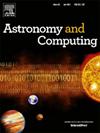FRELLED Reloaded: Multiple techniques for astronomical data visualisation in Blender
IF 1.8
4区 物理与天体物理
Q2 ASTRONOMY & ASTROPHYSICS
引用次数: 0
Abstract
I present version 5.0 of FRELLED, the FITS Realtime Explorer of Low Latency in Every Dimension. This is a 3D data visualisation package for the popular Blender art software, designed to allow inspection of astronomical volumetric data sets (primarily, but not exclusively, radio wavelength data cubes) in real time using a variety of visualisation techniques. The suite of Python scripts that comprise FRELLED have been almost completely recoded and many new ones added, bringing FRELLED’s operating environment from Blender version 2.49 to 2.79. Principle new features include: an enormously simplified installation procedure, a more modular graphical appearance that takes advantage of Blender 2.79’s improved interface, much faster loading of FITS data, support for larger data sets, options to show the data as height maps in 2D mode or isosurfaces in 3D mode, utilisation of standard astropy and other Python modules to support a greater range of FITS files (with a particular emphasis on higher-frequency radio data such as from ALMA, the Atacama Large Millimetre Array), and the capability of exporting the data to Blender 2.9+ which supports stereoscopic 3D displays in virtual reality headsets. In addition, in-built help files are accessible from each menu panel, as well as direct links to a complete wiki and set of video tutorials. Finally, the code itself is much more modular, allowing easier maintainability and, over the longer term, a far easier prospect of migrating to more recent versions of Blender.
frelledreloaded:在Blender中实现天文数据可视化的多种技术
我介绍了FRELLED的5.0版本,即FITS实时资源管理器在每个维度上的低延迟。这是一个3D数据可视化包,用于流行的Blender艺术软件,旨在允许使用各种可视化技术实时检查天文体积数据集(主要但不完全是无线电波长数据立方体)。包含FRELLED的Python脚本套件已经几乎完全重新编码,并添加了许多新脚本,将FRELLED的操作环境从Blender 2.49版本带到2.79版本。主要新特性包括:极大地简化了安装过程,更加模块化的图形外观,利用了Blender 2.79改进的界面,更快地加载FITS数据,支持更大的数据集,在2D模式下以高度图显示数据或在3D模式下以等面显示数据的选项,利用标准astropy和其他Python模块来支持更大范围的FITS文件(特别强调来自ALMA的高频无线电数据,阿塔卡马大型毫米阵列),以及将数据导出到Blender 2.9+的功能,该功能支持虚拟现实耳机中的立体3D显示。此外,内置的帮助文件可以从每个菜单面板访问,以及直接链接到一个完整的wiki和一组视频教程。最后,代码本身更加模块化,允许更容易的可维护性,并且从长远来看,更容易迁移到最新版本的Blender。
本文章由计算机程序翻译,如有差异,请以英文原文为准。
求助全文
约1分钟内获得全文
求助全文
来源期刊

Astronomy and Computing
ASTRONOMY & ASTROPHYSICSCOMPUTER SCIENCE,-COMPUTER SCIENCE, INTERDISCIPLINARY APPLICATIONS
CiteScore
4.10
自引率
8.00%
发文量
67
期刊介绍:
Astronomy and Computing is a peer-reviewed journal that focuses on the broad area between astronomy, computer science and information technology. The journal aims to publish the work of scientists and (software) engineers in all aspects of astronomical computing, including the collection, analysis, reduction, visualisation, preservation and dissemination of data, and the development of astronomical software and simulations. The journal covers applications for academic computer science techniques to astronomy, as well as novel applications of information technologies within astronomy.
 求助内容:
求助内容: 应助结果提醒方式:
应助结果提醒方式:


